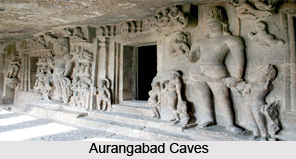 Aurangabad Caves were dug out of soft basalt rock during the 6th and 7th century. These caves are divided into three separate groups depending on their location. Sculptural carving of Aurangabad Caves is a good example of Indian classical art and can be compared to Ajanta paintings.
Aurangabad Caves were dug out of soft basalt rock during the 6th and 7th century. These caves are divided into three separate groups depending on their location. Sculptural carving of Aurangabad Caves is a good example of Indian classical art and can be compared to Ajanta paintings.
Caves I and III of Aurangabad and last caves of Ajanta co-existed. Historians have concluded that cave III was older then compared to cave I. Cave III has neat and organized designs of fretwork, scrolls, panel of couples, tassels, flowers, geometrical designs. Cave 3 is in the form of a chaitya griha of the Hinayana order. Cave 1 is an unfinished vihara. Cave 2 is also a vihara that houses Buddha`s shrine.
The remaining caves are ascribed to the Kalachuri dynasty. Cave 7 is the most elaborate and famous for its sculptures. It has a central shrine with circumambulation with an outer corridor running all around. This corridor has recesses at regular intervals which are carved with various Buddhist gods and goddesses. The front wall has a beautiful representation of a panel of speech Avalokitesvara and Bodhisatva on either side the entrance to the shrine.
The other major sculptural panels are of Tara, principal consort of Avalokitesvara. She is depicted to the left of central shrine door and a group of six female musicians on the left wall of the main shrine. The latter is often considered as the representative sculptural panel of the Aurangabad Caves. The main figure situated at the centre is in a dancing attitude, with the five others playing different musical instruments.
This article is a stub. You can enrich by adding more information to it. Send your Write Up to content@indianetzone.com



















